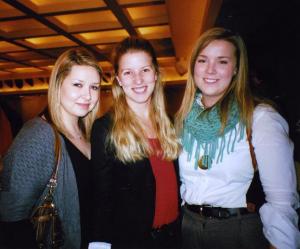“You’re a what?” Mistake number one: the question is not what, but who. “I am Estonian.” Living as an Estonian in a society that, for the most part, misinterprets the name of the country for a disease, is far more appealing than one might think. Estonians like to stick together; where there’s one, you can be sure that more aren’t far behind. Estonians are also a very proud people: insulting an Estonian may result in a volleyball face-off or some sort of alcohol related test of superiority. Our social gatherings might seem like more of a cult ritual, including folk dancing, loud chants, sauna-ing, and ceaseless consumption of beverages. An outsider may feel uneasy and baffled surrounded by such a spirited bunch of platinum blond people. I’ll admit, it takes some getting used to, but being educated about our unique culture and lifestyle might help to ease the divide between Estonians and the rest of the world.
Even people who are Estonian have fallen victim to the awkwardness of the Estonian language. It is not uncommon to find multiple vowels side by side in a singular word, such as “Jää-ääres” for example which directly translate to “edge of ice.” The Estonian alphabet looks similar to that of the English language; however, minor changes have been made. For example, there is no letter C, F, Q, W, X, Y, or Z, but there are two letter A’s and three letter O’s. Other words such as “tee”, for example, have more than one meaning. It can mean either a road, tea for drinking, or the verb “to do”. Estonian verbs have to be conjugated. Fourteen different noun declensions have to be memorized. There are no prepositions therefore the meaning of the sentence relies on the memorization of the declensions. There is, however, one easy thing about the Estonian language that doesn’t even compare with English: it’s completely phonetic. Learning to write in Estonian may prove difficult, but reading it is as easy as wife-carrying.
There are many peculiar cultural aspects of being Estonians that even I don’t understand. Some Estonian folk tales have been passed down from generation to generation and become more and more obscure the longer they’ve been around. At the dinner table one Christmas Eve, my grandmother shared this old folk tale: according to legend, every year, on Christmas Eve, all of the water in the wells on the large Estonian island of Saaremaa turns to vodka for a split second at the stroke of midnight. She also recounted how all of the ferns in Estonia sprout blossoms for a split second at the stroke of midnight on New Year’s Eve. No matter how you argue these two tales, my grandmother stands firm in her belief. Saunas have also been a huge part of Estonian culture since forever. It’s no awkward undertaking for Estonian boys, girls, men, women, relatives, or strangers to enjoy a nice hot sauna together on a Saturday evening. It’s just the way we are.
In the summer of 2009, I had the opportunity to take part in an Estonian national song festival called “Laulupidu.” This festival takes place every five years in Estonia; it welcomes twenty-five thousand singers and one hundred thousand spectators from all around the world. It is a celebration of Estonian language, culture and national pride. The experience is something I will never forget. Standing in the bandstand among twenty-five thousand capable and exuberant singers, all singing the same song and in perfect harmony, makes the hair on the back of my neck stand up just thinking about it. It doesn’t get much more patriotic than that.
Mixed marriages have become a norm among the Estonian communities living outside of the homeland. I, along with many of my friends, am the product of a mixed marriage: only one parent is of Estonian heritage, in my case, my father. Lucky ones have been blessed with fair skin, blond hair, and blue eyes, which distract people from the mixed blood. But no matter what our hair colour, we are just as proud of our heritage and we have embraced the Estonian culture with the same amount of passion and spirit as anyone else.
There is place where all Estonians of every familial configuration can come together and breathe as one. It is called “Jõekääru,” a summer youth camp in Udora, Ontario, and my home away from home. Since the age of four, I have spent my summers at Jõekääru. The cabins are crumbling, the water smells like rotten eggs, and the lake is ridden with leeches, but I love it just the same. At Jõekääru, we learn Estonian traditions such as singing, leatherwork and folk dancing that would have otherwise been forgotten. I have made so many lifelong friendships there, and I know that in the future, I will be sending my kids there just as my dad did for me.
Don’t let the colour of our hair fool you, we’re a bunch of smart cookies! Who do you think invented Skype? Do not fear us; we are your friends and neighbours. There may be few of us but we are not afraid to stand up and shout: “I am Estonian!” And that’s just the way we are.

It’s Just the Way We Are (3)
Eestlased Kanadas | 02 Mar 2012 | Anneliis PõldreEesti Elu
Viimased kommentaarid
Kommentaarid on kirjutatud EWR lugejate poolt. Nende sisu ei pruugi ühtida EWR toimetuse seisukohtadega.
Eesti tähestikus on olemas tähed - C ja F.
Laulupidu oli ikka aastal 2009 ja mitte 2099.
Laulupidu oli ikka aastal 2009 ja mitte 2099.
Kes on fotol?
Eestlased Kanadas
TRENDING


























